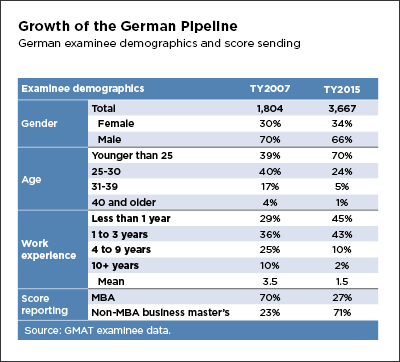Increased interest in non-MBA business master’s programs has transformed the profile of the average German b-school applicant.

In testing year (TY) 2015, five Western European countries hit nine-year GMAT testing highs. Among them, none has seen as sharp a rise in the number of examinees—or as dramatic a shift in their demographic composition—than Germany.
The German candidate pipeline grew from 1,804 unique examinees in TY2007 to 3,667 unique examinees in TY2015, an increase of more than 100 percent. During this nine-year period, the proportion of female examinees rose from 30 percent to 34 percent. At the same time, the share of German examinees younger than 25 grew from 39 percent to 70 percent, and German examinees’ average amount of work experience decreased from 3.5 years to 1.5 years.
The primary driver of these demographic shifts is the notable increase in the number of German examinees interested in pursuing non-MBA business master’s programs. German examinees sent 71 percent of their GMAT score reports to these programs in TY2015, up from only 23 percent in TY2007. Around the world, as well as in Germany, non-MBA business master’s candidates tend to be more female, younger, and have less work experience on average.

For details on the shifting demographics of business school candidates from countries around the world, explore the Profile of GMAT Testing: Citizenship Report and the more than 160 country-specific Geographic Trend Reports available at gmac.com/geographictrends.